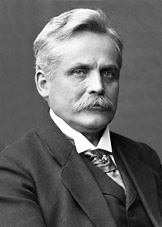Wilhelm Wien
| Wilhelm Wien | |
 Wilhelm Carl Werner Otto Fritz Franz Wien
|
|
| Born | 13 January 1864 Fischhausen, East Prussia |
|---|---|
| Died | 30 August 1928 (aged 64) Munich, Germany |
| Residence | Germany |
| Nationality | German |
| Fields | Physicist |
| Institutions | University of Giessen University of Würzburg University of Munich RWTH Aachen University |
| Alma mater | University of Göttingen University of Berlin |
| Doctoral advisor | Hermann von Helmholtz |
| Doctoral students | Karl Hartmann |
| Known for | Blackbody radiation |
| Notable awards | Nobel Prize for Physics (1911) |
Wilhelm Carl Werner Otto Fritz Franz Wien (German: IPA: [/viːn/]) (13 January 1864 – 30 August 1928) was a German physicist who, in 1893, used theories about heat and electromagnetism to compose Wien's displacement law, which relates the maximum emission of a blackbody to its temperature.
Contents |
Early life
Wien was born at Fischhausen (Rybaki), Province of Prussia (now Primorsk, Russia) as the son of landowner Carl Wien. In 1866, his family moved to Drachstein, in Rastenburg (Rastembork.
Education
In 1879, Wien went to school in Rastenburg and from 1880-1882 he attended the city school of Heidelberg. In 1882 he attended the University of Göttingen and the University of Berlin. From 1883-85, he worked in the laboratory of Hermann von Helmholtz and, in 1886, he received his Ph.D. with a thesis on the diffraction of light upon metals and on the influence of various materials upon the color of refracted light. From 1896 to 1899, Wien lectured at the prestigious Aachen University of Technology. In 1900 he went to the University Würzburg and became successor of Wilhelm Conrad Röntgen.
Work
In 1896 Wien derived a distribution law of radiation, later named after him Wien's displacement law. Planck, who was a colleague of Wien's when he was carrying out this work, later, in 1900, based quantum theory on the fact that Wien's law, while valid at high frequencies, broke down completely at low frequencies. In 1900 (following the work of George Frederick Charles Searle), he assumed that the entire mass of matter is of electromagnetic origin and proposed the formula  for the relation between electromagnetic mass and electromagnetic energy.
for the relation between electromagnetic mass and electromagnetic energy.
While studying streams of ionized gas, Wien, in 1898, identified a positive particle equal in mass to the hydrogen atom. Wien, with this work, laid the foundation of mass spectroscopy. J. J. Thomson refined Wien's apparatus and conducted further experiments in 1913 then, after work by Ernest Rutherford in 1919, Wien's particle was accepted and named the proton.
Wien received the 1911 Nobel Prize for his work on heat radiation.
Bibliography
- Lehrbuch der Hydrodynamik (1900, physics)
- Aus dem Leben und Wirken eines Physikers (1930, memoir)
See also
- Wien's Distribution Law
- History of special relativity
- Mass–energy equivalence
References
- Wien, W. (1904) „Über die Differentialgleichungen der Elektrodynamik für bewegte Körper“ / [|"On the differential equations of the electrodynamics for moving bodies"] ; Annalen der Physik (Series 4), 13(4), 641-662, 663-668; (but now as digitized German text, with parallel English translation, plus extra references and footnotes). For a facsimile of the original (part 1 only), follow the "Band 318" link from [[1]].
- E. Rüchardt (1955). "Zur Erinnerung an Wilhelm Wien bei der 25. Wiederkehr seines Todestages". Naturwissenschaften 42 (3): 57–62. doi:.
- E. Rüchardt (1936). "Zur Entdeckung der Kanalstrahlen vor fünfzig Jahren". Naturwissenschaften 24 (30): 57–62. doi:.
External links
- Wilhelm Wien
- O'Connor, John J.; Robertson, Edmund F., "Wilhelm Wien", MacTutor History of Mathematics archive
|
||||||||
| Persondata | |
|---|---|
| NAME | Wien, Wilhelm |
| ALTERNATIVE NAMES | |
| SHORT DESCRIPTION | Physicist |
| DATE OF BIRTH | January 13, 1864 |
| PLACE OF BIRTH | Fischhausen, East Prussia |
| DATE OF DEATH | August 30, 1928 |
| PLACE OF DEATH | Munich, Germany |